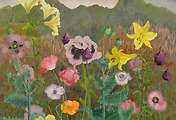









루이스 포러(Louis Faurer), 미국, 사진가, 1916-2001
“내가 보는 삶을 기록하고 싶은 강렬한 욕망"을 그의 유일한 동기.
“내가 놀랍고 경악하는 한, 사건, 메시지, 표현 및 움직임이 모두 기적과 함께 관통된다고 느끼는 한, 나는 내가 계속해야 할 확신으로 가득 차 있다고 느낄 것이다 “
그는 뉴욕과 필라델피아 거리의 사진을 찍으며 도시 생활의 쉴 틈 없는 에너지를 포착했다. 그의 사진들은 그 도시의 매우 다양한 인간 얼굴을 보여준다.
Faurer는 블러, 그레인, 이중 노출, 샌드위치형 네거티브, 반사, 느린 필름 속도, 낮은 조명으로 실험했다. 1950년 뉴욕의 샌 게나로 페스티벌에서 로버트 프랭크와 그의 새 아내 메리가 찍은 사진들이 그 대표적인 예인데, 초점이 맞지 않는 광원들의 반사와 할레이션을 이용하여 친밀하고 낭만적인 결과를 얻어낸다.
About Him
Louis Faurer (1916-2001) was born to immigrant parents from the Russian/Polish border and spent his early years in South Philadelphia. After graduating from the South Philadelphia High School for Boys in 1934, he spent a few summers as caricature artist in Atlantic City, New Jersey. Inscriptions of all sorts fascinated him, and he began studying at Philadelphia's School of Commercial Art and Lettering in 1937. He also worked freelance--painting advertising signs and lettering posters. That same year, Faurer purchased his first camera, a used 35mm Kodak Vollenda. Shortly thereafter, he won a prize in a weekly photo contest of the Philadelphia Evening Public Ledger. Faurer never attended classes in photography, except for a brief course he took in the military (from 1941-1945, he was a civilian photographer for U.S. Army Signal Corps, Philadelphia).
In the late 1940s, Faurer and several of his colleagues from Philadelphia opened studios in New York. Like many photographers of his generation, Faurer sought employment working for magazines, but unlike his photojournalist peers, who pursued careers at such publications as Life magazine, he gravitated toward fashion photography. In 1947, Lillian Bassman, the first art director of the short-lived Junior Bazaar (later incorporated into Harper's Bazaar), invited him to join the magazine's staff. The new magazine also hired Robert Frank, a recent immigrant from Switzerland, and the two immediately struck up a friendship that would last for fifty years.
Faurer was a key member of the New York School of street photographers active from the 1930s to the 1950s. A loosely defined group that included Diane Arbus, Robert Frank, and William Klein, the New York School chose city life as its subject, preferred 35mm cameras, and rejected traditional documentary styles.
During the 1950s, he began to focus more on his professional assignments than on his own personal street photography, working steadily for magazines such as Glamour, Charm, and Seventeen, Vogue and Mademoiselle. He created most of his fashion photographs in the studio.
In 1968, Faurer moved to London and then to Paris to escape trouble with the Internal Revenue Service and conflict with his wife. He returned to street photography in Paris, but his photographs from this period lack the clarity of vision that marks his work from the 1930s through the early 1950s. When he returned from Europe in 1974, he tried to resume photographing the streets of New York, but both he and the city had changed. In the fall of 1984, as he was exiting a bus, Faurer was struck by a car. This serious injury effectively ended his career as a photographer. He died in 2001 in New York.
루피노 타마요(Rufino Tamayo), 멕시코, 화가, 1899-1991
루피노 타마요(Rufino Tamayo), 멕시코, 화가, 1899-1991'루피노 타마요'는 개성이 너무 강한 탓에 다니던 미술학교를 자퇴하고, 독학으로 그림공부를 한, 멕시코의 화가입니다. 멕시코 원주민 전통예술
mkpark03.tistory.com
베르나르 뷔페(Bernard Buffet), 프랑스, 화가, 1928-1999
베르나르 뷔페(Bernard Buffet), 프랑스, 화가, 1928-1999날카로운 직선으로 삐쩍 마른 인물들을 그린 '베르나르 뷔페 Bernard Buffet(1928~1999)'가, 작가이자 가수인 '애나벨 Annabel'을 처음 만난 것은 1958년 여
mkpark03.tistory.com
샤를 자크(Charles Jacque), 프랑스, 화가, 1813-1894
샤를 자크(Charles Jacque), 프랑스, 화가, 1813-189419세기에 프랑스 파리와 바르비종(Barbizon)을 중심으로 활동을 전개한 근대 풍경화가이다. 샤를 자크는 유화와 판화 분야에서 두루 뛰어났으며, 양 떼
mkpark03.tistory.com
'생활 > 예술' 카테고리의 다른 글
| 페드로 로이즈(Pedro Ruiz), 콜롬비아, 현대미술가, 1957-현재 (2) | 2024.09.19 |
|---|---|
| 세드릭 모리스(Cedric Morris), 영국, 화가, 1889-1982 (0) | 2024.09.18 |
| 코르네유(Corneille, Guillaume Cornelis van Beverloo), 네덜란드, 화가, 1922-2010 (0) | 2024.09.18 |
| 조세프 코테(Josef Kote), 알바니아, 화가, 1964-현재 (1) | 2024.09.18 |
| 빅토리아 볼(Victoria Ball), 영국, 프리랜서 작가, 1980-현재 (0) | 2024.09.18 |




댓글